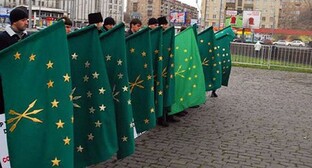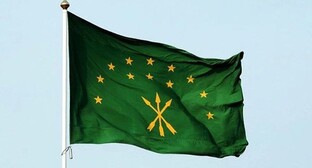03 June 2003, 13:22
Khazars and the Khazar kaganate
Khazars are a Turk-speaking people that appeared in the Eastern Europe after the invasion of Huns (IV century) and wandered in the West-Caspian steppe. Byzantians knew them in the VII century under the name of the eastern Turks. In the same century they strengthened their positions on the shores of the Pont (the Black sea), in the VIII century they conquered the major part of Taurida (Crimea) and the northern shores of the Black sea and formed the state called Khazar kaganate (it existed from the middle of the VII till the end of the X century) with kagan at the head. The capital of the kaganate was Semender (on the territory of modern Dagestan), in the middle of the VIII century the city Itil (in the delta of the Volga River).
Originally the economic base of existence of Khazar Kaganate were nomadic cattlebreeding and agriculture, later it became more profitable to trade with the peoples of Eastern Europe, Central Asia, Transcaucasia and other regions.
In the second half of the VII century Khazars subdued part of the Azov Bulgarians as well as Saviors in the coastal Dagestan; Caucasus Albania became a tributary of Khazar kaganate. Approximately at the same time Khazars had defeated several times the Arab invaders that were trying to conquer the Caucasus and the Black sea coast. In the year 654 the Arab military leader Khabib Ibn-Maslama occupied Armenia and Georgia, while Salman Ibn-Rabikh-al-Balkhi occupied Albania. His brother Abd-ar-Rakhman conquered Derbent and from there moved to the country of Khazars towards Belenjer ( the ancient capital of Khazaria in the valley of the river Sulak where the foothills turn into the valley), but he couldn?t take that fortress. In 684 Khazars had a big military operation in Transcaucasia. They devastated several districts, took military trophies and the prisoners of the war. These events started long wars between Arabs and Khazars that lasted for over a century. During the Arab-Khazar war until 735 there were mutual invasions, devastation of the territory of the enemy and a cruel fight for Derbent.
By the beginning of the VIII century Khazars possessed the North Caucasus, all the Azov sea coast, the major part of the Crimea as well as the steppe and the forest-steppe territories of Eastern Europe up to the river Dniepr. In 735 Khazars were defeated by the army of the Arab man-of-war Mervan. His army of 150 thousand soldiers managed to enter the territory of Khazaria and to reach its new capital Itil, then moved along the right coast of the Volga to the north, following kagan that tried to gather forces to repulse. Mervan reached the Slav river (many researchers think that it?s Don) and captured 20 thousand families of "Slavs and the other non-Moslems". Having learned that the Arabs devastate the country of Burtas, followed them along the left bank of the Volga, hoping to attack Mervan unexpectedly and to defeat him. But the latter turned out to be more experienced in the military tricks. Having learned about the movement of Khazars, at night time he moved to the opposite bank along the pontoon bridge. In an accidental fight the scouts killed the Khazar military leader, then the Arabs unexpectedly attacked the Khazar army and defeated it. Having learned about it, kagan asked for peace. Mervan demanded that kagan became a Moslem, otherwise his protege will take the Khazar throne. Kagan accepted Islam. Coming back, Mervan strengthened his positions in Dagestan, the local rulers paid tribute to caliph.
At that period of time the main occupation of the population of Khazar kaganate was nomadic cattle-breeding. In the valley of the Lower Volga there was agriculture and horticulture. The capital of the kaganate Itil became an important center of crafts and international (including transit trade). Settlements appeared between the rivers Don and Donets as some of the North-Caucasus Alans moved there. Early feudal relations started to form. The power in the state got concentrated in the hands of the local Khazar and Bulgarian feudal lords, while the kagan became a respected but powerless ruler.
The power of Moslems in the kaganate didn?t last for a long time. As early as the first half of the VIII century part of the Khazars of the North Dagestan accepted Judaism. During the VIII century Khazars had good relationship with Byzantium, this helped the spreading of Christianity. Byzantians were allowed to form a mitropoly on the territory of Khazar kaganate that consisted of 7 eparchies. In the second half of the VIII century revolts started in the Arab caliphate, this helped Khazars to return the main districts of the North Caucasus. In 799 Khazars intruded Transcaucasia, but that was their last big action. In the IX century the weakened kaganate continued to face at the Caucasus an equally weakened caliphate. Khazars and Byzantians constantly argued about the Crimean provinces, that?s why Christianity also couldn?t beacon a state religion that the Khazar kaganate needed to unite the peoples inhabiting it. Hostility to Christians and Moslems caused the official adoption of Judaism by the top of Khazar society in the end of the VIII - beginning of the IX century during the reign of kagan Obadia (786-809). The choice turned out to be wrong, already in the first years it caused disunity in the country. The new religion didn?t unite, but split the federative formation headed by Khazars. The adoption of Judaism by kagan, tsar and Itil nobility opposed them to the nobility in the provinces and to the main mass of population. There started the civil war, in its course perished Obadia and his two sons. The civil dissention lasted for several years and weakened the state significantly.
In the end of the IX century the northern coast of the black sea was conquered by Pechenegs, in 895 they drove towards Danube Madyars that were dependants of the Khazar kaganate. Byzantium, interested in weakening the kaganate, set up the surrounding nomads against the Khazars. The ancient Russian state became the main force that faced the Khazar kaganate. In the IX century the south-eastern Slav tribes paid tribute to Khazars, but already at that time the Russian armed forces began to penetrate to the Caspian sea. In 913-14 and 943-44 the army of Russians passed Khazaria and devastated the Caspian coast. In 964-65 prince Svyatoslav Igorevich defeated Khazars and took the city Sarkel during his military voyage to Itil (Volga). Later in 968-69 his army destroyed the cities Itil and Semender. In the second half of the X century Khazars tried to improve the situation with the help of Khorezm, but they had no success. In the end of the X century Khazar kaganate stopped to exist and Khazars got assimilated by the other peoples.




